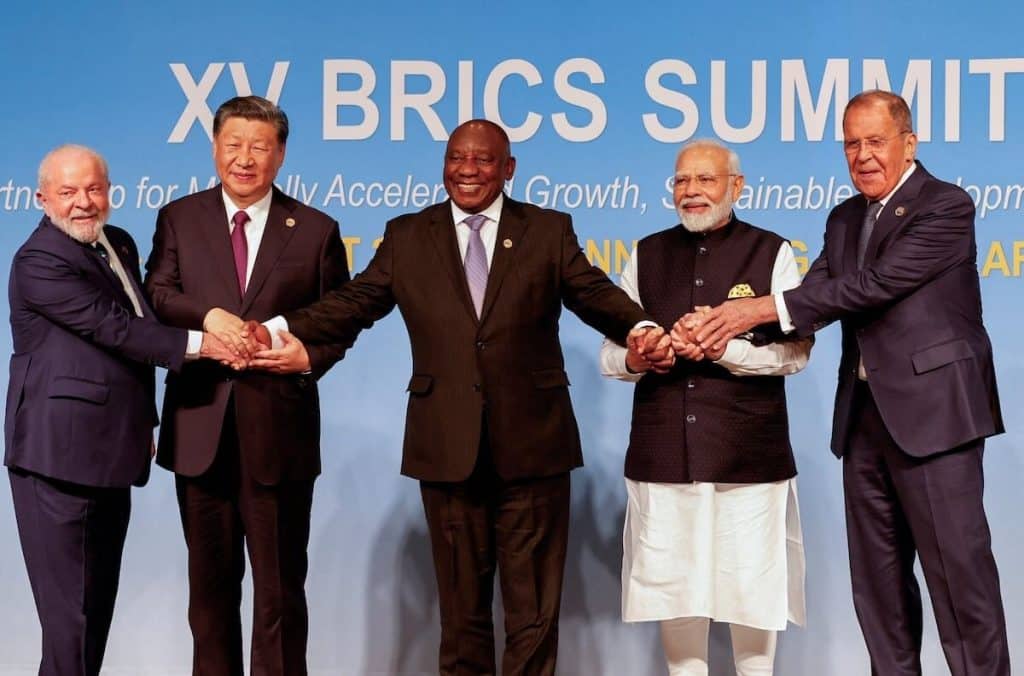China, India, and Brazil: Emerging powers that will not bow to Trump’s tariffs.
In an analytical note, the Spanish newspaper El Pais assessed the “power show” of China, India and Brazil “against Donald Trump’s aggressive tariff policy, which is unprecedented in modern times,” differently from the approach of “Europe and Japan” and emphasized: Europe and Japan quickly backed down against the pressure of the US president to avoid a costly and unpredictable confrontation. But a group of emerging powers, all members of the BRICS, are standing up to Trump’s America.
India and Brazil, both with the heaviest tariffs (50 percent), and China and South Africa with tariffs of around 30 percent, have preferred not to give in. Friday’s telephone conversation between Trump and his Chinese counterpart, Xi Jinping, confirmed the results of this strategy, at least in the short term. After the conversation, both leaders showed an image of understanding, although they did not reveal details about the future of the tariff war.
Washington’s Motives and Reasons
In the case of China, the tariffs are a combination of economic and geopolitical motives: Washington’s huge trade deficit with Beijing and the fear that China will overtake the US as the world’s leading economy.
In the case of India, there is an external factor at play: close ties with Russia. The White House argues that its massive oil purchases from Moscow indirectly finance Russia’s war machine in Ukraine.
In the case of Brazil and South Africa, the motive is overtly political: the trial of former President Jair Bolsonaro, a close Trump ally, and the alleged abuse of Afrikaner farmers.
However, all of these countries, especially the first three, are strongly opposed to Washington’s trade policy change. They are ready to negotiate, but much more firmly than the European Union, Mexico, or Canada, which, despite their harsh rhetoric, have repeatedly given the green light to avoid a complete break in trade relations.
China: Resisting with Minimum Damage
China has resisted Trump more than any other power and has so far remained largely unscathed. The experience of the tariff war during Trump’s first term has prepared Beijing for a second term. It has identified the sectors where it could hurt the US the most and has responded to each tariff with a counter-tariff. At the same time, it has challenged each new round of tariffs at the World Trade Organization, a move that the European Union, a staunch defender of the Geneva-based intergovernmental body, has not done.
The note continues: China has even resorted to belligerent rhetoric, reviving Mao’s words during the Korean War: “No matter how long this war lasts; we will never surrender.” An official spokesman stressed that Beijing is ready to confront the US “to the end” – whether in a tariff war or any other war.
The confrontation reached its peak in April: the US imposed a 145% tariff on Chinese goods, and Beijing imposed a 125% tariff in return. Chinese exports to the US fell by 64%, trade was effectively closed, and the trade wall was now tantamount to a de facto embargo. Then Beijing stepped in and restricted exports of minerals vital to advanced and defense industries.
That brought Washington to the negotiating table. The two sides managed to calm the situation since May with two high-level meetings between the heads of the ministries of economy and trade and two phone calls between Trump and Xi Jinping. As announced on Friday, these meetings will be followed by face-to-face meetings in October and then in 2026. After the initial call, US tariffs on China were reduced to 30% and on the other side to 10%. Washington declared a ceasefire until August; The ceasefire was then extended until November.
China has used Trump’s new geopolitics against the great powers to present itself to the rest of the world as a reliable economic partner and advocate for globalization. This has led to a significant improvement in relations with India, a country with which it has had a long list of diplomatic disputes and border clashes.
New Delhi: From Ally to Rival
India, the world’s most populous country, an emerging power, and the world’s fifth-largest economy, has been a cornerstone of the US strategy to counter China’s rise. However, its energy ties with Russia, from which it buys vast quantities of oil at below-market prices, have been Trump’s argument for imposing his tariffs. At the end of July, as the relative ceasefire expired, Washington imposed a 25% tariff on Indian products.
Seeing that Indian Prime Minister Narendra Modi was not budging, Trump announced that he would double the tariff to 50 percent. When the tariff went into effect in late August, one voice came to New Delhi’s defense: Beijing. Three days later, the Indian prime minister landed in China, where he joined Xi and Russian President Vladimir Putin for an ambitious summit.
The Shanghai Cooperation Organization summit, which brought together about 20 leaders, served as a platform for China to once again use its diplomatic charm in the face of Trump’s obstructionist policy. It is perhaps the most striking example of how aggressive tariffs can backfire on the United States, alienating a historic ally in a region as important as the Asia-Pacific and bringing it closer to a systemic rival. This was clearly seen in the recent celebrations in Tianjin and Beijing.
Brasilia: Lula da Silva’s nationalist response
When Trump punished Brazil with a 50% tariff, he himself admitted that his motives were political, not commercial. The Republican politician has no qualms about the system.

